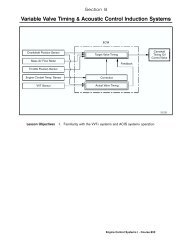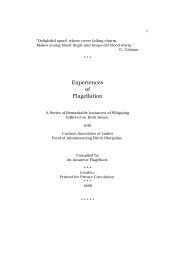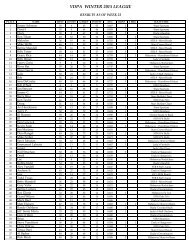Brake Pad Bedding Procedure - NewsGuy
Brake Pad Bedding Procedure - NewsGuy
Brake Pad Bedding Procedure - NewsGuy
You also want an ePaper? Increase the reach of your titles
YUMPU automatically turns print PDFs into web optimized ePapers that Google loves.
PAGID Racing<br />
http://www.braketechnology.com/brakepadbedding.html<br />
Page 1 of 3<br />
7/07/2011<br />
<strong>Brake</strong> <strong>Pad</strong> <strong>Bedding</strong> <strong>Procedure</strong><br />
PLEASE NOTE:<br />
IT IS IMPERATIVE THAT THE BEDDING IN PROCEDURES ARE BEING DONE ONLY ON A RACE TRACK. PAGID<br />
RACING MATERIAL IS NOT LEGAL FOR STREET USE.<br />
Why bedding?<br />
• To transfer a layer of friction material onto the brake disc faces to achieve maximum performance.<br />
• To stabilize compressible materials to avoid a spongy pedal.<br />
• To boil off volatile elements in the friction compound in order to have the initial ‘green’ fading during bedding and not<br />
during the race.<br />
• To align the pad surface with the brake disc surface to have full contact.<br />
If pads do not get bedded properly and / or used too hard right out of the box will likely lead to pad glazing. <strong>Pad</strong> glazing is a<br />
condition where the resins in the pad crystallize on both, the pad friction surface and the brake disc surface, resulting in poor<br />
stopping performance, brake judder and vibrations.<br />
Also rapidly escaping volatile elements and moisture from the resin would seek an immediate escape route out of the friction
PAGID Racing<br />
Page 2 of 3<br />
compound, creating small fissures that would lead shortly to cracking and chunking.<br />
1.) BASIC BEDDING IN<br />
To initiate some heat in the brake discs and pads.<br />
• 4 to 6 stops with medium brake pressure from approximately 150 km/h (90 MPH) to approximately 80 km/h (50 MPH).<br />
• Distance between each brake stop approximately 300 - 400 meters (300 to 400 yards).<br />
• The pads should not reach temperatures above 400° Centigrade (550° Fahrenheit).<br />
• No dragging!<br />
• Blocking of the air ducts might be helpful to reach appropriate temperatures quicker.<br />
2.) IMMEDIATELY AFTER BASIC BEDDING IN AT HIGH SPEED<br />
Simulating race conditions<br />
• One stop with medium to heavy brake pressure, without allowing brakes to lock from approximately 180 km/h (110<br />
MPH) to approximately 80 km/h (50 MPH).<br />
• No dragging!<br />
• Recovery stops with light brake pressure 3 to 4 times. (Cleaning procedure)<br />
• Repeat the high-speed stops including recovery stops 2 to 3 times.<br />
• Allow a cool-off distance of approximately 500 m (500 yards) between high-speed stops.<br />
BRAKE DISCS<br />
If possible, pads should be bedded on used but NOT worn out brake discs.<br />
Pagid brake pad material can be used either on solid, grooved or cross-drilled discs.<br />
For disc bedding please refer to the disc manufacturers’ own instruction.<br />
MOUNTING NEW PADS ON USED DISCS<br />
http://www.braketechnology.com/brakepadbedding.html<br />
7/07/2011
PAGID Racing<br />
http://www.braketechnology.com/brakepadbedding.html<br />
Page 3 of 3<br />
7/07/2011<br />
Edges of pad surface should be filed roughly to 45 degrees to ensure that the pad carries fully and evenly and is not touching<br />
the edge of the disc.<br />
Do not use discs, which are pre-bedded, or have been used with friction material other than PAGID.<br />
PAGID racing pads are developed for high performance events. Motorsport is dangerous.<br />
PAGID racing pads are sold without warranty, expressed or implied. No warrant or<br />
representation is made as to this product’s ability to protect the user from injury or death.<br />
The user assumes that risk.<br />
©2006 <strong>Brake</strong> Technology of America







